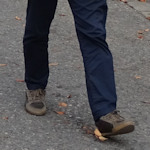The compact centre makes it easy to walk between the sights in Vienna, but which route should you take? Here my suggestion for your walking tour, with insider tips along the way and links to detailed descriptions of the sights you pass.
- Route starts at the opera house
- Ends at the cathedral
- Includes the top sights in the centre
- Takes about 90 mins at a decent pace
- Book a guided walking tour* of the city
- See also:
This is part 1, which takes you from the opera house to the edge of the central Hofburg palace complex. Then you move on to:
- Part 2 (covers the Hofburg)
- Part 3 (a section of the Ring)
- Part 4 (back through the old town to the cathedral)
Walking route for the centre

(The west side of the opera house with its arched colonnade)
We shall begin at the main entrance to the Staatsoper opera house, since you can reach this easily from just about anywhere: either on foot from the centre or via trams to Oper/Karlsplatz (lines 1, 2, D, 62 and 71) or subway to Karlsplatz (U1, U2 and U4).
Incidentally, if you’d prefer to tour the city from the comfort of a seat, then the opera house is also a main stop for Vienna’s hop on hop off buses.
Route map
Part 1 covers the orange markers below:
The opera house
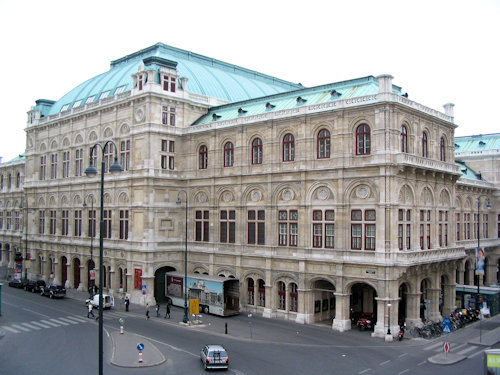
(The back of the opera house)
Opened in 1869, the Staatsoper counts as one of the world’s top opera venues and also provides a home to the state ballet.
Performances change each night thanks to an experienced ensemble and an orchestra drawn from the expert ranks of the Wiener Philharmoniker.
Despite the uniformly historical look, what you see of the building is only partly original: the rest is an accurate reconstruction after WWII bombing damage.
Casual visitors can view little of the interior. However, the opera house kindly hosts guided tours so you can walk around the insides without attending an actual performance.
As you face the main entrance of the Staatsoper, walk along to the left and take the road on your right (down the lovely colonnade that funnels you past the stage door).
This is Operngasse and leads into the centre.
Tip: the Staatsoper sells inexpensive standing tickets; enjoy world-class opera for the price of coffee and cake.
The Albertina
As you emerge from the colonnade, look across to the other side of the road; you see a wall fountain and, above it, an equestrian statue with the Albertina palais and art museum behind:
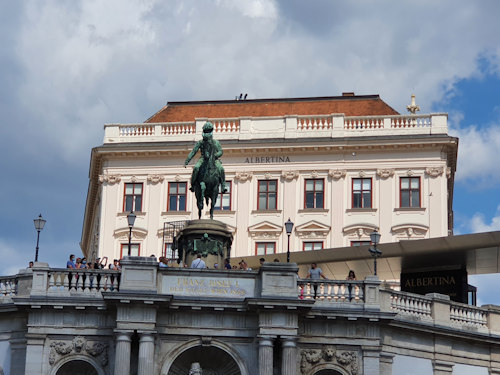
(The chap on the horse is Archduke Albrecht)
Cross over the road to walk past the Albertina on your left, but not before you take everything in.
The Albertina itself dates back to the 1740s. Once a home to various archdukes, it now houses an extraordinary collection of art.
A visit includes a permanent exhibition featuring the likes of Picasso, a self-guided stateroom tour, and a changing repertoire of special exhibitions that cover everything from Renaissance art to contemporary sculpture.
Tip: go up to the platform in front of the Albertina for excellent photos of the Staatsoper and views across to the Burggarten park and Neue Burg (which you see later on this walking tour).

(View of the opera house from the Albertina platform)
The 1899 equestrian statue is Archduke Albrecht (1817-1895), one-time owner of the Albertina and Habsburg military personality.
The 1869 roadside Albrechtsbrunnen wall fountain has a river theme, with the personification of the Danube at its centre, his arm around Vindobona representing Vienna. The other figures all represent tributaries of the Danube.
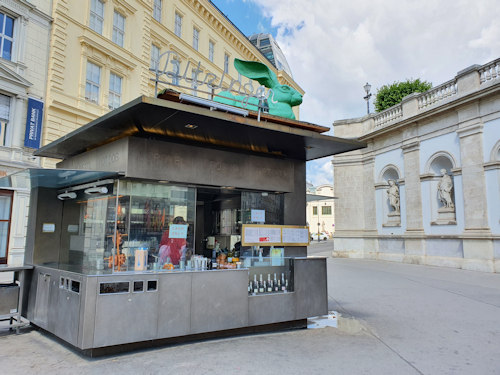
(Bitzinger sausage stand)
Two contrasting culinary treats sit nearby:
- The Bitzinger booth in front of the fountain might be Vienna’s most famous sausage stand and often has queues (Mick Jagger popped in on a recent Rolling Stones tour). The rooftop hare hints at the nearby Albertina’s most famous artwork: Albrecht Dürer’s 1502 Young Hare
- One of Vienna’s traditional coffee houses lives opposite the Albertina. Café Mozart has a long history that includes becoming a favoured haunt of the cast and crew of The Third Man

(Part of the monument against war and fascism)
An entranceway just behind the Bitzinger booth and opposite the Albertina offers another chance to experience some modern and contemporary art: the Heidi Horten Collection at Hanuschgasse 3 (home to exhibitions drawing on that prestigious archive).
As you continue walking down past the Albertina, look back to see the museum steps with their artful stair painting and across to the monument against war and fascism by Alfred Hrdlicka (erected in 1988, which feels a little belated given the topic).
Augustinerkirche
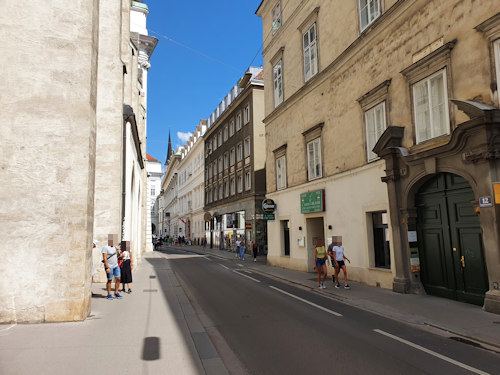
(Augustinerstraße)
You should now be following the pavement and road a little to the left down Augustinerstraße.
Before you leave the open square area, though, look right to spot the Theatermusuem in the 17th-century Palais Lobkowitz. The building hosted the first performances of Beethoven’s 3rd and 4th symphonies.
Your route now takes you down the side of the 14th-century Augustinerkirche, former long-serving court church to the Habsburgs.
The location presided, for example, over weddings for Emperor Franz Joseph (to the famous Sisi), Empress Maria Theresa, Napoleon Bonaparte, and King Louis XVI of France (the latter two in the absence of the grooms, which I didn’t realise was an option).

(The Sobiesky plaque)
The road continues past Dorotheergasse on your right, which houses, for example, the Jewish Museum‘s main site and the local cultural icon that is the Hawelka coffee house (I recommend you try the Buchtel pastries).
Just after the junction with Dorotheergasse, look for a plaque on the outside wall of the Augustinerkirche bearing the name Jan Sobiesky.
The Polish king attended mass in the church on September 13th, 1683, fresh from defeating the Ottoman forces and lifting the siege of Vienna in a seminal moment for European history.
Josefsplatz
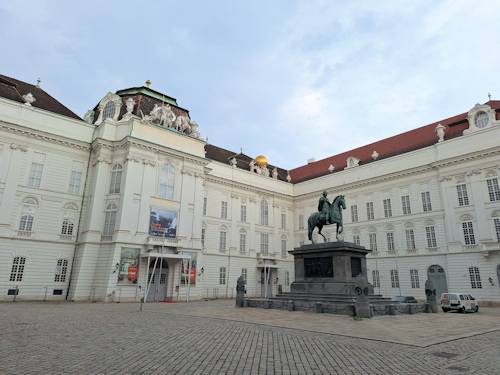
(Josefsplatz with the national library on the left)
You now reach Josefsplatz square, which marks the effective boundary of the great Hofburg complex, one-time home to the Habsburg dynasty.
Consider Josefplatz your first real taste of historical Vienna, since just about every building on it still looks much like it did decades or centuries ago.
As you continue down the road you pass two palais buildings on your right: Palais Pálffy (reconstructed after WWII) and the 18th-century Palais Pallavicini.

(The entrance caryatids to Palais Pallavicini)
The scantily clad statues outside Pallavicini led to some “excitement” at the time of construction. More recently, that same portal and palais appeared in The Third Man as the home to Harry Lime, whose “fatal” road accident took place outside.
The square itself has the unassuming entrance to the Augustinerkirche on one side. Nip inside to see the remarkable 1805 Canova memorial for Archduchess Marie Christine , who died in 1798.
The side opposite the road has the entrance to the State Hall of the National Library. I urge you to take a break and have a look at the so-called Prunksaal inside.

(Yeah, not your average municipal library. Good luck trying to borrow one of the books on display; press photo © Österreichische Nationalbibliothek/Hloch)
This is one of those libraries you see on Instagram: a towering haven of Baroque architecture, ceiling frescoes, and books that look like leather-bound grimoires full of dark magic.
The final side of the square is the exterior of the Redoutensäle rooms.
Habsburg monarchs put those rooms to good use for concerts, banquets, balls and various events intended to entertain and/or impress in equal measure. They now serve as administrative areas and (commercial) event locations.
And in the centre of the square we have another equestrian statue: this time from 1807 and featuring Emperor Joseph II (1741-1790) himself. (It seems spelling was more flexible back in the day.)
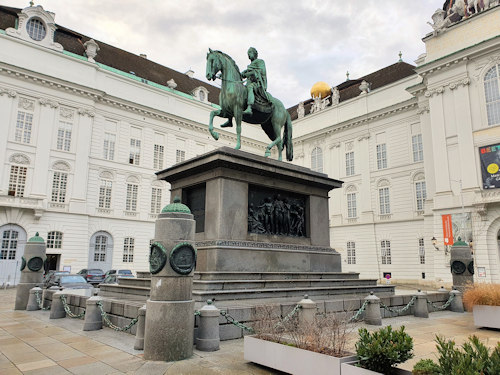
(The statue mimics the one of Marcus Aurelius that once stood on the Capitoline Hill in Rome)
The Joseph statue has reliefs on the surrounding pillars that represent events and accomplishments from the monarch’s reign.
Walk on past the square while keeping the road to your left and head toward the archways.
Before you reach the exit from the square, though, glance down the road leading away to the right (Bräunerstraße): Tanzschule Elmayer is one of Vienna’s more notable ballroom dancing schools.
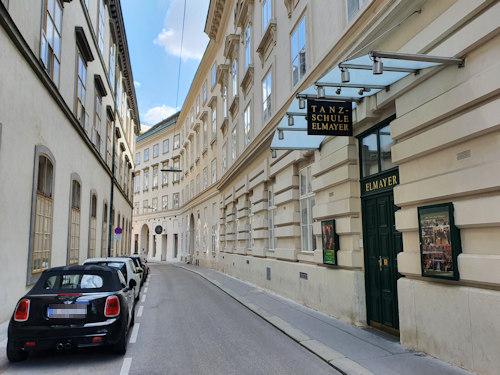
(You pass Bräunerstraße on your right)
The archways will take you to and past the Renaissance Stallburg stables used by the stallions of the Spanish Riding school.
Here we’re now on the second part of your walking tour: the Hofburg and Habsburgs.
